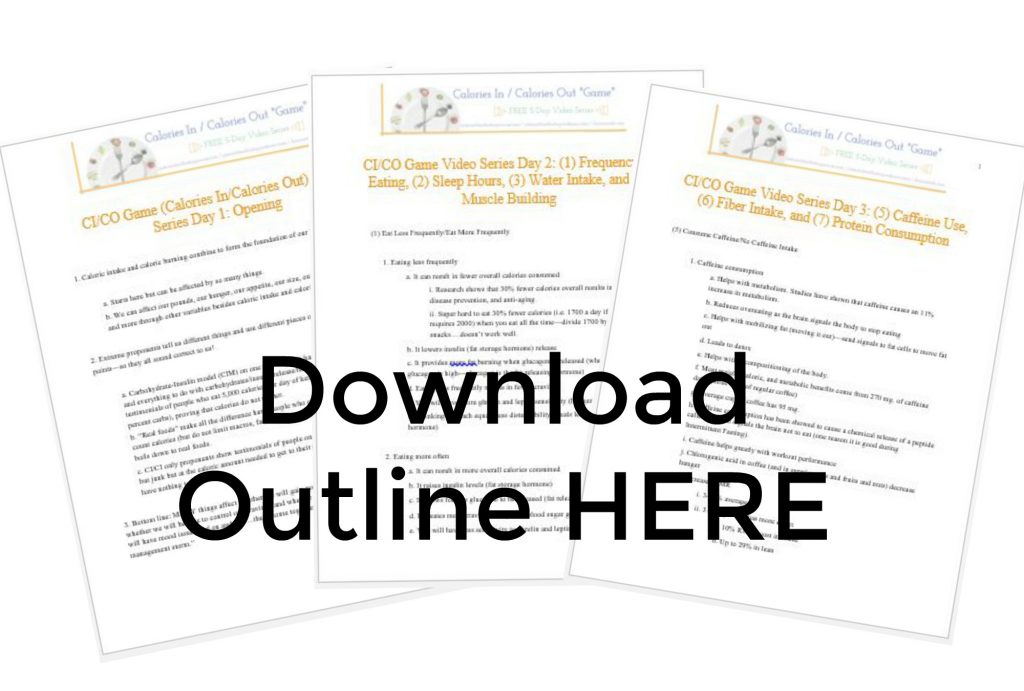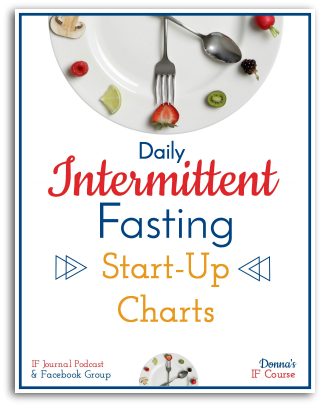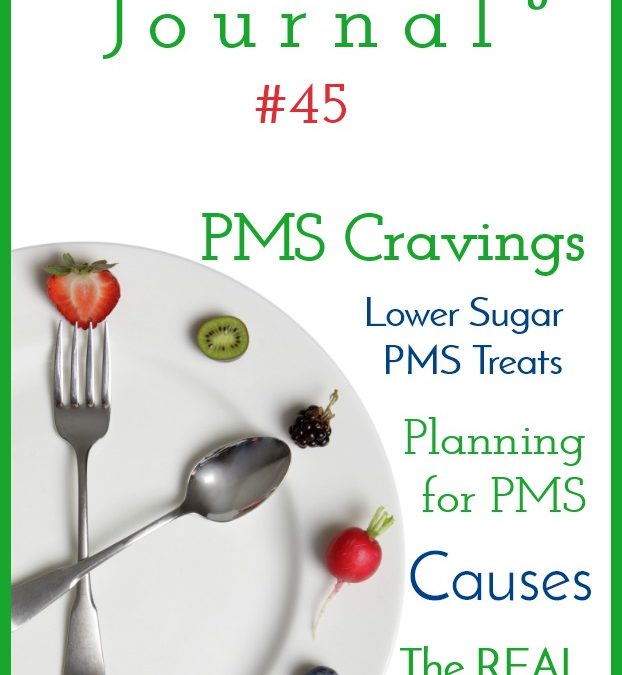
Intermittent Fasting Journal #45
In this Broadcast, Donna Reish, blogger, author of 100 curriculum books for preschool through twelfth graders, seeker of health and fitness, and Intermittent Fasting teacher, talks about PMS cravings and mood issues and how to handle them with Intermittent Fasting and...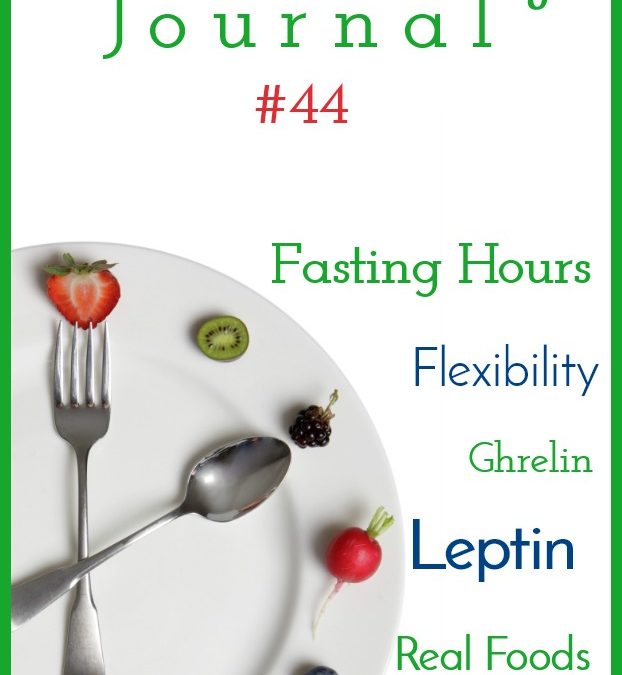
Intermittent Fasting Journal #44
In this Broadcast, Donna Reish, blogger, author of 100 curriculum books for preschool through twelfth graders, seeker of health and fitness, and Intermittent Fasting teacher, talks about what to expect after one month of fasting and what to focus on for your fasting...
Intermittent Fasting Journal #42
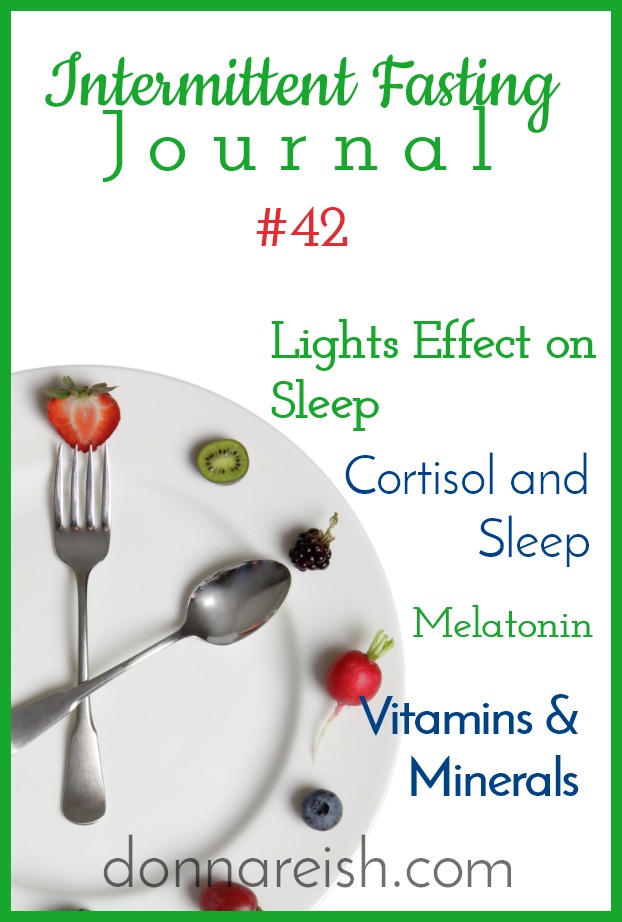
In this Broadcast, Donna Reish, blogger, author of 100 curriculum books for preschool through twelfth graders, seeker of health and fitness, and Intermittent Fasting teacher, talks about ways to improve sleep. She begins the broadcast with her and her husband’s fasting update and what she has been learning about processed foods and Appetite Correction through applying Dr. Stephan Guyenet’s The Hungry Brain teaching to fasting. Basically, she explains, seductive, processed, calorie-dense, high trigger foods do not signal AC as well, so she and her husband are learning to save these foods for dinners out and “parties” and eat less seductive foods at home—while not considering what the macros of these foods are (i.e carbs are bad or fats are bad).
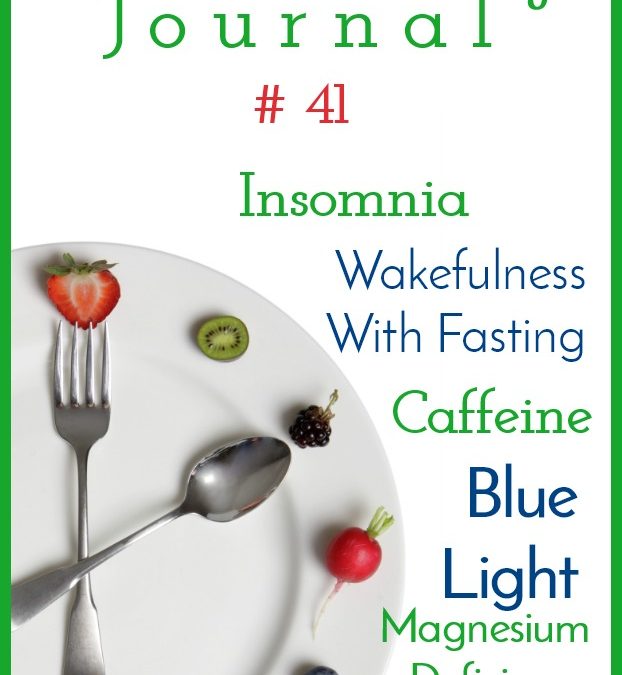
Intermittent Fasting Journal #41

In this Broadcast, Donna Reish, blogger, author of 100 curriculum books for preschool through twelfth graders, seeker of health and fitness, and Intermittent Fasting teacher, talks about insomnia and Intermittent Fasting. She begins the broadcast with her and her husband’s fasting update and what she has been learning about calorie cycling—and how many IF’ers who are within 20 pounds of their goal weight do a version of calorie cycling without even realizing it or counting calories. She describes how making food restrictions based on occasions and eating at home can help us break through plateaus and set us up for healthier eating overall.
Donna then digs into the topic of insomnia—and how our circadian rhythms are related to insomnia as well as to our fasting and eating cycles. She describes potential causes for insomnia as related to fasting—including hunger, lack of satiety, and lack of food satisfaction. She also describes how IF-related insomnia usually subsides within a week or so and how IF actually gives deeper and better sleep overall. Then she moves into typical reasons for insomnia, describing how they affect our sleep and wake patterns. These include caffeine, blue light, exercise, lack of activity/napping/sleeping late, magnesium deficiency, and subdued melatonin release.
This week’s broadcast is sponsored by Plexus supplements. Specifically, Donna taught about Plexus’ new metabolism/cortisol-reducing/thyroid aiding MetaBurn today! This natural, plant-based product is loaded with amazing adaptogens as well as other incredible mood and metabolism-boosting ingredients. Donna is offering a FREE private FB group centered around weight management coaching and teaching for all of her wholesalers and customers in the coming year!

Intermittent Fasting Journal #40
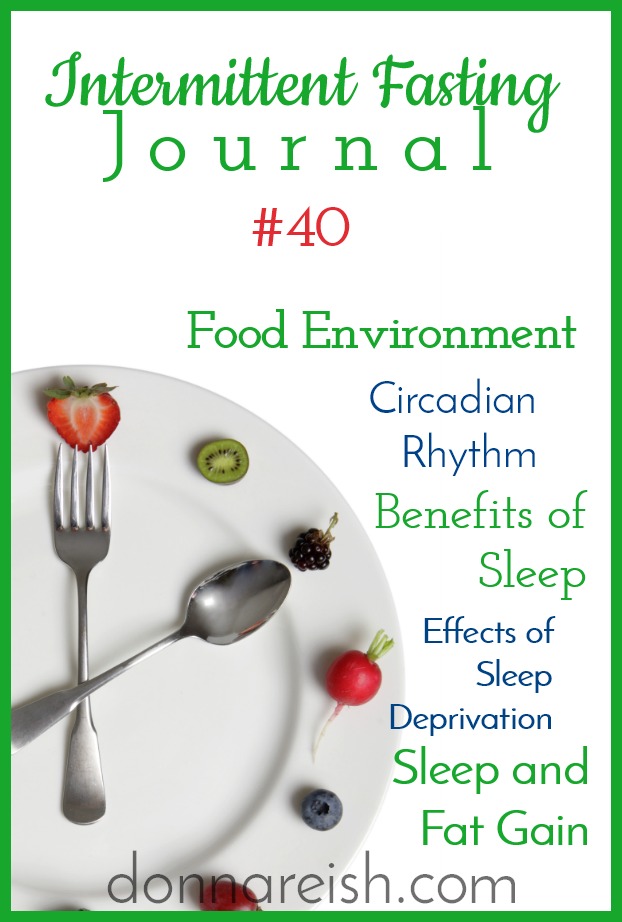
In this Broadcast, Donna Reish, blogger, author of 100 curriculum books for preschool through twelfth graders, seeker of health and fitness, and Intermittent Fasting teacher, talks about the benefits of adequate sleep and the downside of too little sleep. She begins the broadcast with her and her husband’s fasting update and what she has been learning from Dr. Stephan Guyenet’s book, The Hungry Brain. Specifically, Donna points out how important it is to control our food environment if we want to reduce our processed food intake and eat more real foods/less calorie dense foods on a regular basis—and how to make treats into the “special occasions” that they should be. Then she digs into statistics on sleep in general—how much we sleep today vs thirty years ago; circadian rhythms, and more. Next, Donna gives the many benefits of sleeping 7 to 9 hours each night (including its effect on weight management efforts). Then she goes into detail about the detriments of too little sleep, which include lowering of Human Growth Hormone, raising of cortisol (stress hormone), lessening of our response to leptin (satiety hormone), and much more. This week’s broadcast is sponsored by Plexus supplements. Specifically, Donna taught about Plexus’ magnesium supplement, BioCleanse, today! Donna is offering a FREE private FB group centered around weight management coaching and teaching for all of her wholesalers and customers in the coming year!

Intermittent Fasting Journal #37

In this Broadcast, Donna Reish, blogger, author of 100 curriculum books for preschool through twelfth graders, seeker of health and fitness, and Intermittent Fasting teacher, shares with listeners more of the “things she has learned after one year of Intermittent Fasting.” This is Part II of this topic—in Broadcast #36 she talked about how she realized she had been “dieting” on too much food/too many calories; how she can control food–food doesn’t have to control her; how overweight is not always our fault; and that sustainability is everything. In this episode, she continues with why IF is the best weight management approach for her due to her ability to adhere to it. Severe restrictions or cutting out entire foods and food groups result in immediate failure as soon as the individual goes to a party or eats out. With IF, this continually failure is not a part of the faster’s life—and success breeds success whereas failure breeds failure. Next, Donna describes the many avenues of freedom that Intermittent Fasting has brought her, including food freedom, financial freedom, time and resource freedom, decision freedom, and much more. Next Donna talks about one of her favorite new “lessons” from her year of IF—the importance of sleep on hormone balancing, metabolism, brain function, and more. Lastly, Donna describes how IF has led her to become a fitness person—someone who works out regularly, builds strength and muscle, and keeps her fitness commitments. This has been another area that eluded her prior to IF, so it is an exciting one to her! This week’s broadcast is sponsored by Plexus’ new thyroid, adrenal, metabolism, and mood product, the all natural MetaBurn!
Get More Info!
(1) Free “Calories In/Calories Out” Game Video Series
(3) FREE One-Hour IF Webinar (last week of each month)
(4) Month-Long IF Course (daily video teaching, outlines, graphics, and more!)
CI/CO Game Video Series Day 5: (11) Intermittent Fasting vs. No Fasting Periods

Click HERE to view day 1, HERE to view day 2, HERE to view day 3, and HERE to view day 4!
Scroll down to view video and to download the game board!!
(11) Fasting Balances the Body to Work FOR You Rather Than AGAINST You!
1. Benefits of fasting
a. Fasting keeps insulin (fat storage hormone) low and glucagon (fat releasing hormone) high to help you burn body fat.
b. Fasting puts you into a fat adaptive/metabolic flexible state so that when you are done burning your glucose for the day, you move right into body fat burning.
c. Fasting trains ghrelin so that you do not have continual waves of hunger.
d. Fasting trains leptin to tell you that you are full sooner during the eating window.
e. Fasting gives you Appetite Correction—so that you are not hungry during the fast, you crave healthier foods, and you stop eating sooner.
f. Fasting boosts metabolism by 12-14 percent.
g. Fasting helps lower cortisol levels, which helps with insulin regulation and cravings.
h. Fasting puts your body into ketosis/fat burning 20 times sooner than a traditional diet. (The keto diet puts you into fat burning 4 times sooner than a traditional diet.)
i. Fasting helps your body tell your satiety signals you are full during the meal as opposed to 20 minutes later like many traditional eating plans.
j. Fasting causes a small calorie deficit, which retains the metabolic rate compared to very low calorie diets, which have been shown to slow the metabolism down by 15% above the normal “lower weight slow down” that one has when losing weight, according to “starvation studies.”
k. Fasting causes you to go from being a sugar burner to being a body fat burner.
2. Downfalls of having a very short period of time without food (i.e. eating 10-20 times per day over 16 hours or so)
a. More calories consumed
b. Insulin never low, so consistently storing fat
c. Cravings are pronounced as you want more as you eat more often and high insulin/sugar keeps us craving processed carbs
d. Too much “food noise” to hear hunger hormone (Grehlin) and satiety hormone (leptin)
e. Many non-fasters use reduced calorie diets in which they take calories down extremely low in order to lose weight
i. Research shows that people on VLCD regain at least 60% of their weight within 12 months; after 5 years, most will regain all; 30% will weigh more.
ii. Too hard to stick with over the long term (since you are often hungry, can’t eat treats because they are too calorie dense, etc.)
iii. Metabolic effects on VLCD are very poor—studies show as much as 250 calorie reduction burning at rest after following VLCD (above and beyond how your metabolism is lowered by the pounds you have lost)—10-12 calories per pound of weight lost is expected…VLCD are hurting metabolism far more than is just from pounds lost alone
iv. Even a 3 week VLCD has been shown to decrease metabolism by 100 calories per day!
v. Studies show that consistently following VLCD can increase ghrelin by 40% over 6 months! HUNGER continuously!
vi. Ghrelin increased when calories go too low
Links for More Info:
Sign up for a FREE webinar HERE
Sign up for a month-long fasting course HERE
Videocast/Podcast: Episode #12—Fat Adaption, Bringing in Boundaries
Videocast/Podcast: Episode #19—Insulin, Glucagon, and Fasting
Videocast/Podcast: Episode #25—Managing Your Life With IF
FREE Intermittent Fasting Start Up Charts HERE
CI/CO Game Video Series Day 3: (5) Caffeine Use, (6) Fiber Intake, and (7) Protein Consumption

Click HERE to view day 1 and HERE to view day 2!
Scroll down to view video and to download the outline and game board!!
(5) Consume Caffeine/No Caffeine Intake
1. Caffeine consumption
a. Helps with metabolism. Studies have shown that caffeine causes an 11% increase in metabolism.
b. Reduces overeating as the brain signals the body to stop eating
c. Helps with mobilizing fat (moving it out)—send signals to fat cells to move fat out
d. Leads to detox
e. Helps with recompositioning of the body.
f. Most weight, caloric, and metabolic benefits come from 270 mg. of caffeine daily (three cups of regular coffee)
g. Average cup of coffee has 95 mg.
h. Caffeine consumption has been showed to cause a chemical release of a peptide called YY that signals the brain not to eat (one reason it is good during Intermittent Fasting).
i. Caffeine helps greatly with workout performance
j. Chlorogenic acid in coffee (and in supplements and fruits and nuts) decrease hunger
k. Increases RMR
i. 3-11% average
ii. 3 cups per day has more effect
a. 10% RMR boost in obese
b. Up to 29% in lean
2 Non-Coffee Drinkers
a. Those who do not consume coffee may get those benefits elsewhere, such as
i. Natural caffeine pills
ii. Caffeinated water (unflavored)
iii. Tea, etc. (not energy drinks, which often have calories, sugar, and questionable ingredients).
b. Decaf coffee also has great effects on Peptide YY (PYY—Peptide Tyrosene Tyrosene)
i. Considered the 3rd satiation hormone
ii. Delays gastric emptying
(6) Eating Fiber/Not Eating Fiber
1. More fiber intake
a. RDA
i. 30-38 grams for men; 25 grams for women (21 grams for women 51 and over)
ii. OR 14 grams of fiber for each 1,000 calories of TDEE
b. Usually results in more real food/fewer calories overall
c. Since fiber takes longer to leave the stomach, you feel full longer/consumer fewer calories More stomach space taken up so less space for other foods
d. Fiber helps metabolism get boosted. Since fiber is not digested, the GI system works harder when it is eaten, resulting in better increase in metabolism.
e. Gives better GI motility.
f. May take healthy fiber supplement to help fill the stomach for feeling of fullness (as long as it’s real and doesn’t result in loose stools, etc.)—simply supplementing the fiber you eat in your diet.
g. Six grams of soluble fiber (totaling 24 calories) has been shown to have the satiating effect of 260 calories in terms of signals to hunger hormones!
h. Fill stomach w/ 6 cups of veggies first!
2. Less fiber
a. Usually means more processed foods, fewer fruits and vegetables eaten,
b. Less stomach distensibility since other foods are not as large or as space-filling as fibrous foods are. You simply have room in your stomach for more foods/more calories.
c. Processed foods are not as easily recognized by leptin (the satiation hormone), so you won’t be signaled to stop eating as early as you are with fibrous and other real foods.
d. Less fiber can lead to irregularity/bloating/bigger waist.
(7) Eating More Protein/Eating Too Little Protein
1. Adequate protein
a. Revs the metabolism. Research has shown that eating adequate protein can rev the metabolism by 15-30% for a few hours following. (However, carbs and fats only have a thermic effect of 3-10%.)
b. Keeps you full longer. Protein helps you feel full longer because it is slow to digest—and it has been found to signal satiety hormones better than carbs or fats. (Again, big surge in PYY)
c. Reduces muscle loss.
d. Decreases total caloric intake. Studies have shown that people eating 30% of their calories in protein consume 441 fewer calories overall. This could be from any number of things, including
i. More calories from protein means fewer calories from fat and carbs;
ii. Fewer grams of fat means fewer calories since fat has 9 calories per gram;
iii. Fewer carbs overall likely means less processed foods AND fewer cravings, again resulting in fewer calories overall.)
e. Someone who has had trouble losing weight often does well with 35% of their calories coming from protein. (This can be up to 175 grams for someone consuming 2000 calories per day—or .75 grams of protein per pound of body weight.)
f. Adequate protein means a reduction in muscle loss.
g. Protein can replace foods that ghrelin does not respond well to
i. Processed foods
ii. Sugar
iii. Liquid calories
iv. Fast eating (more a leptin issue)
2. Too little protein
a. Usually means less real foods (protein takes longer to prepare than quick foods)
b. Less satiety since protein is the most satiating macro nutrient
c. Less muscle building (which can mean less calorie burning!)
d. Again, potentially more calories from carbs and fats.
Links for More Info:
Sign up for a FREE webinar HERE
Sign up for a month-long fasting course HERE
Videocast/Podcast: Episode #32—Caffeine, Peptide YY, Cortisol
Videocast/Podcast: Episode #26—Calorie Cycling, Macros
Videocast/Podcast: Episode #27—Figuring TDEE/Protein
CI/CO Game Video Series Day 2: (1) Frequency of Eating, (2) Sleep Hours, (3) Water Intake, and (4) Muscle Building

Scroll down to view video and to download the outline and game board!!
(1) Eat Less Frequently/Eat More Frequently
1. Eating less frequently
a. It can result in fewer overall calories consumed
i. Research shows that 30% fewer calories overall results in longevity, disease prevention, and anti-aging.
ii. Super hard to eat 30% fewer calories (i.e. 1700 a day if your body requires 2000) when you eat all the time—divide 1700 by 6 meals and snacks….doesn’t work well.
b. It lowers insulin (fat storage hormone) release
c. It provides more fat burning when glucagon is released (when insulin is low, glucagon is high—glucagon is the fat releasing hormone)
d. Eating less frequently results in fewer cravings
e. You will have more ghrelin and leptin sensitivity (hunger hormones).
f. Shrinking stomach equals less distensability equals less ghrelin (hunger hormone)
2. Eating more often
a. It can result in more overall calories consumed
b. It raises insulin levels (fat storage hormone)
c. It allows for less glucagon to be released (fat releasing hormone)
d. It creates more cravings every time blood sugar goes up and down
e. You will have less sensitivity to ghrelin and leptin (hunger hormones)
(2) Sleep 7-9 Hours a Night/Sleep Under 7 Hours a Night—According to Centers for Disease Control and Prevention, 35% of people are sleep deprived!
1. Sleeping 7 hours or more a night
a. It results in more release of Human Growth Hormone (HGH), which helps you create muscle, burn calories (released in deep, long sleep between 4 and 6 am)
b. It leads to fewer cravings
c. It provides a boost in metabolism
d. It gives you better insulin sensitivity
e. Leads to more regulating of hunger hormones (ghrelin and leptin)
f. Helps you have better workouts
g. Way less stress hormone (cortisol—a hormone that increases hunger and cravings, and much more!)
2. Inadequate sleep has been shown in study after study to negatively affect weight management
a. High link to obesity and insulin resistance
b. Sleeping six hours or fewer affects ghrelin and leptin (hunger and satiation hormones)
c. One study showed that just sleeping one to two hours less caused a 24-30% increase in hunger
d. A study on obese women at the same caloric intake had great fat loss until they divided the groups in two and the second half reduced their sleep, resulting in half the fat loss from that point on from the other group (with no caloric or energy expenditure changes)
e. Research shows a 55% reduction in fat loss for sleep deprived people.
f. Another study showed a 30% drop in insulin sensitivity after four days of sleep deprivation.
g. Studies show that sleeping under six hours results in lower leptin levels, higher ghrelin levels, and a distinct trigger in the brain requiring more food.
h. Inadequate sleep slows down Human Growth Hormone (hGH).
(3) Adequate Water Intake/Inadequate Water Intake
1. Drinking adequate water
a. It results in drinking fewer sugary drinks (fewer overall calories, less insulin spike)
b. Gives a metabolic boost
c. Helps with fat mobilization
d. Tricks ghrelin into thinking there is food in the stomach
i. Ghrelin produced from gut and tells hypothalamus/brain you are hungry.
ii. Can be trained
iii. Water and sparkling water helpful for ghrelin
iv. Comes in ten minute waves
e. Gives less chance for dehydration (which is often confused with hunger…dehydration can cause you to eat more)
f. Provides earlier meal satiation
g. Has shown to lower caloric intake
h. Gives better detox Fat and toxins are released through water.
i. Provides hydration of the liver. Hydrated liver helps with fat loss.
j. Water increase is associated with 44% more weight loss.
k. Study of American Academy of Dieticians found that people who drank 1-2 glasses of water before eating ate 75-100 fewer calories.
l. Just 17 ounces of water has been shown to boost metabolism by 10-30% for up to one hour following.
2. Drinking inadequate amounts of water
a. Results in dehydration. Dehydration often confused with hunger so more calories are consumed.
b. More stomach space for food (so more caloric intake). Water is not taking up space in the stomach so more calories are consumed.
c. More caloric drinks consumed resulting in insulin spike; liquid sugar not recognized by hunger hormones (and stored as fat more easily)
d. Less removal of fat and toxins.
(4) Build and Preserve Muscle/No Concern for Muscle
1. Muscle can be built and/or preserved through adequate protein intake, Intermittent Fasting, working out, eating enough calories, increasing Human Growth Hormone (HGH), weight and resistance training, and HIIT exercises.
a. Muscles burn calories all the time—increasing your TDEE (Total Daily Energy Expenditure)…you can eat more!
b. Muscles make you look much better
c. When fat is decreased and muscle is increased, you have an inch loss/size reduction in clothing
2. We do not build or preserve muscle when we
a. Eat little protein
b. Do not work our muscles
c. Eat too many processed foods
d. Have little Human Growth Hormone
e. Eat more calories than we need (which are converted to fat).
Links for More Info:
Sign up for a FREE webinar HERE
Sign up for a month-long fasting course HERE
Videocast/Podcast: Episode #17—Ghrelin and Human Growth Hormone
Videocast/Podcast: Episode #20—Longer vs. Shorter Eating Windows
Videocast/Podcast: Episode #30—Ghrelin and Caloric Needs
Videocast/Podcast: Episode #33—Sleep and More
FREE Intermittent Fasting Start Up Charts HERE

